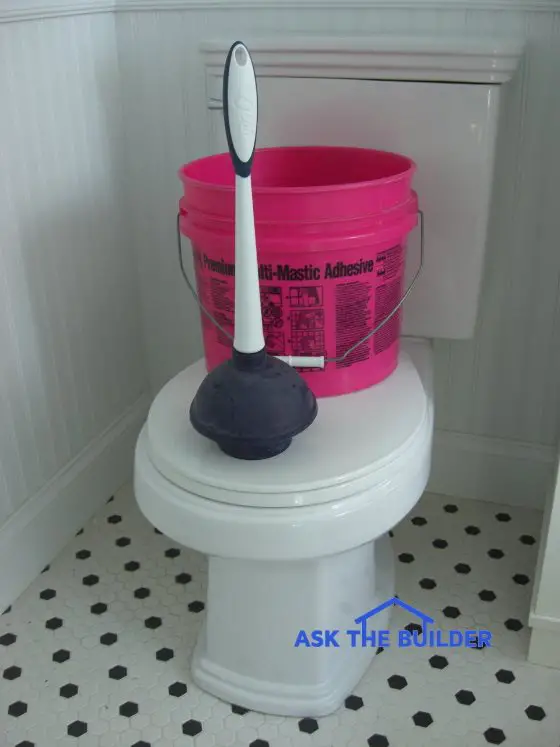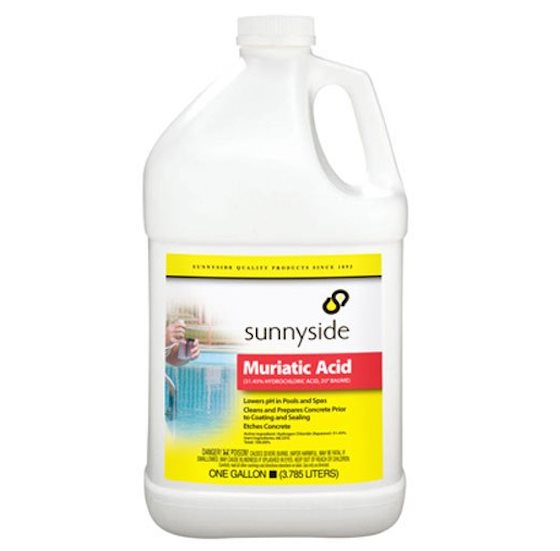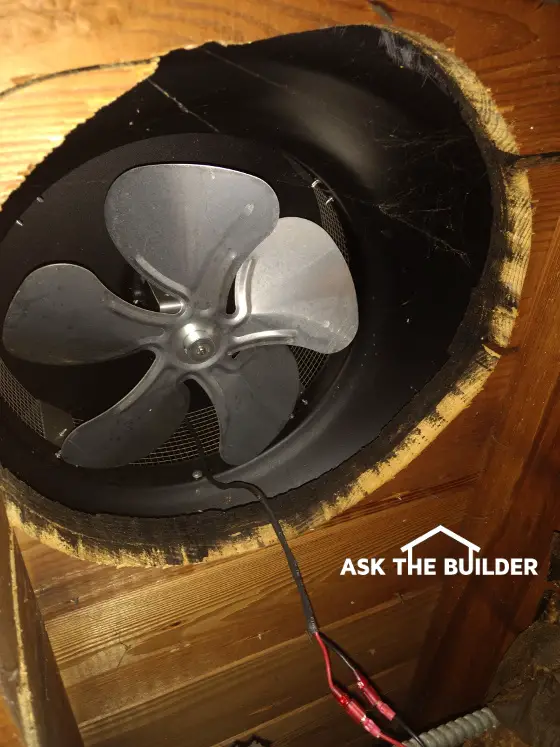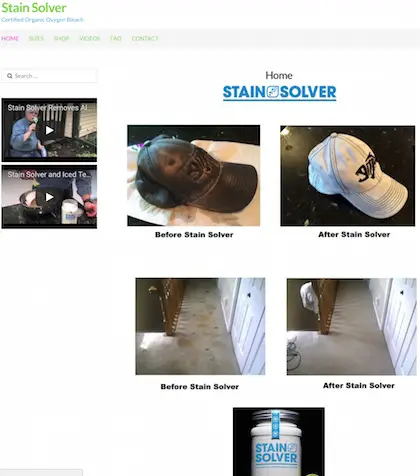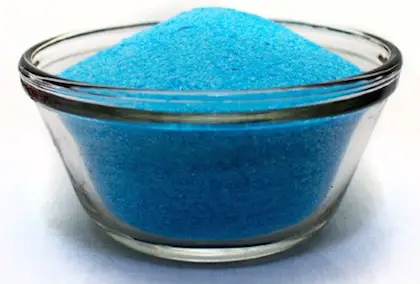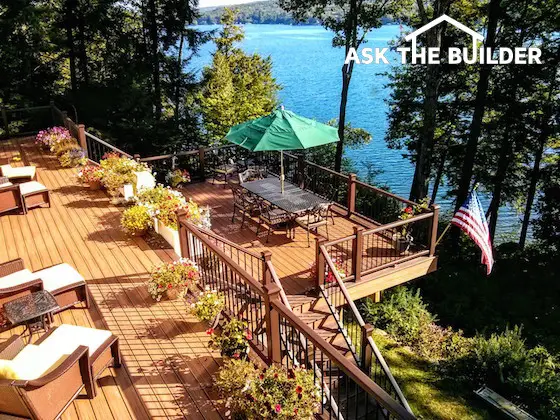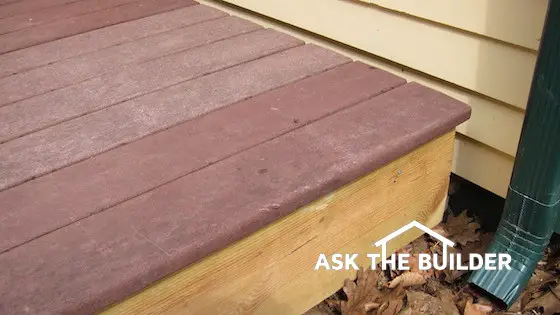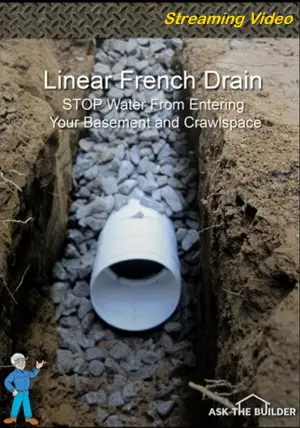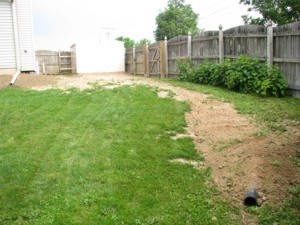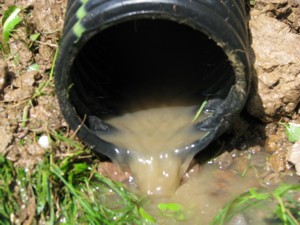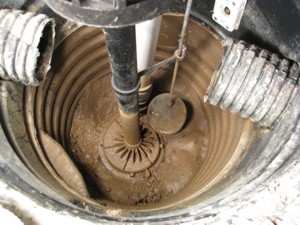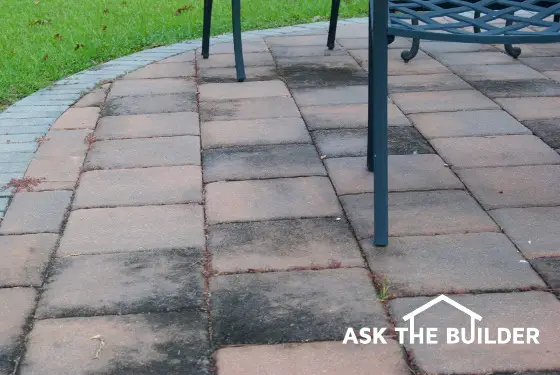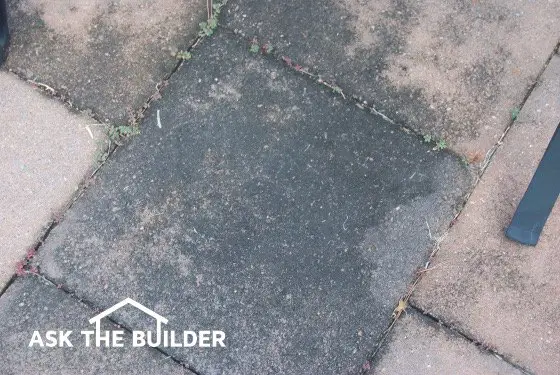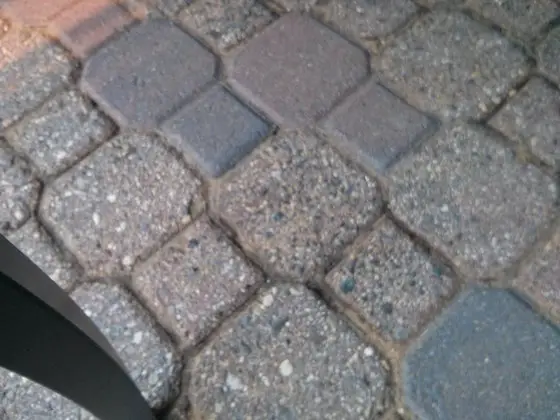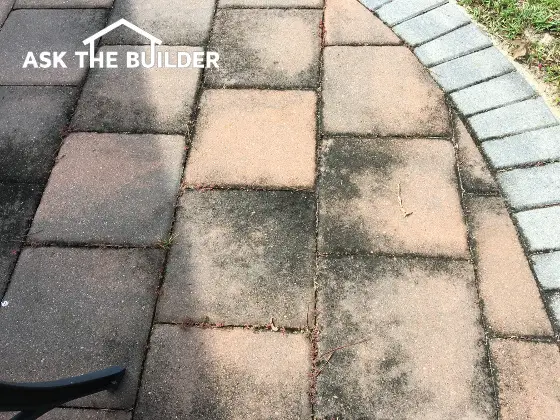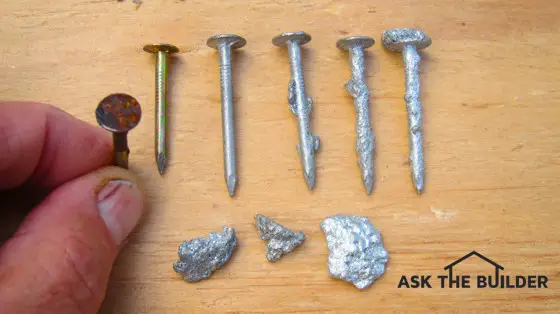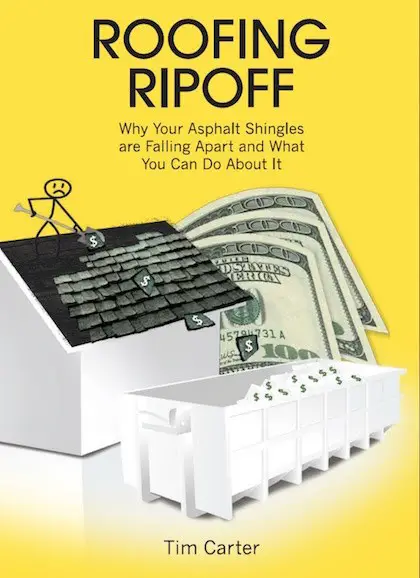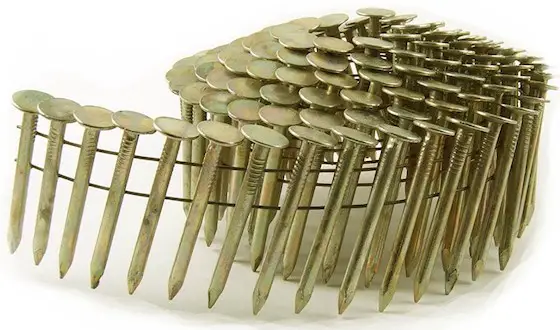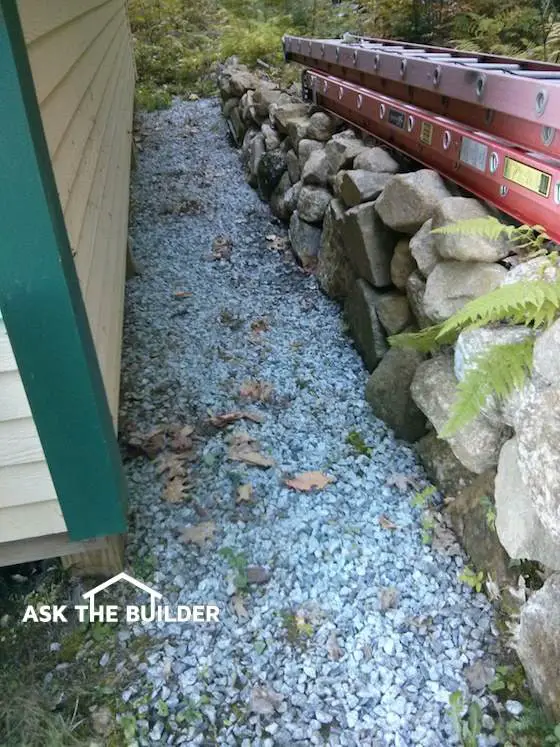
This standing water next my own shed is unacceptable. I finished the shed in late fall and was unable to start to work on the wall and drainage issues until the spring. It can cause many different problems. There are several ways to solve the problem. Look at the after photo below. Copyright 2017 Tim Carter
"Adding soil to the low spots is usually not a good method to fix poor drainage problems. There's a much better way to dry the soil."
Water Drainage Checklist
- The ground around your home must slope away from the foundation
- More slope is better
- Watch the linear french drain video below
- A trench drain will solve subsurface water problems
- CLICK HERE to Get Tim's FREE & FUNNY Newsletter!
DEAR TIM: Spring is here and so are the incessant heavy rains. I have several places near my house where water ponds and I need some water drainage tips from you.
It can't be a good thing for my house, as I constantly am battling water in my basement and part of the house that has a crawlspace under it. My lot isn't really that flat, so I'm at a loss as to what's going on.
Do I have to call a professional to solve this issue, or can I just add soil to fill in the low spots? What are my options to get the standing water away from my home? Marion R., Evansville, IN
Water Drainage Solution | Let Gravity Suck Water From the Soil
DEAR MARION: While I don't have accurate statistics to support my feelings, I suspect you're in a vast majority of homeowners who have varying degrees of poor drainage issues on their land or near their homes. You're correct in assuming that ponding water is not a good thing for houses.
How Can a Geology Degree Solve Water Drainage Problems?
A geology degree can solve water drainage issues because water and soil are a core area of study.
My college degree was in geology. I gravitated to two disciplines within geology: geomorphology and hydrogeology. Geomorph, as we students affectionately called it, is the study of the Earth's surface features. Hydrogeology examines ground and subsurface water. I studied these topics for three years while in college.
Both of these areas of geology are especially relevant when it comes to understanding and solving water drainage issues.
If you think about the Earth on a very large scale and take into consideration gravity, you quickly discover that Mother Nature is doing her best to constantly carry all soil, rock, your house, your car, your possessions and you down and into the oceans.
Mother Nature is also a very patient woman. She also has a split personality.
Her evil twin is constantly pushing land out of the ocean. This tectonic activity builds mountains where two crustal plates crash into one another. This is why the Earth has dry land that we build upon.
Related Links
Avoid Ponding Water from Roofs
Perfect Grading Around Foundations
Select the Best Lot With Great Drainage
Drain Water From Your Wetland Lot
Free & Fast Bids
How Much Land Slopes Around My House?
Lots of land can be sloping towards your home. I have a giant mountain just above my house that funnels water towards my home.
What does all this have to do with the water at and around your home? Simple. Topographic maps can be found online. Older topographic maps are sometimes archived and might show what your land looked like before it was developed.

This is a topographic map from Google Maps. You just select the Terrain option from the menu to see it. Note the red arrow pointing to the gray line that has the number 800 on it. Any point on that line is 800 feet above sea level as the number. The magenta arrow points to where my house is. The land slopes quite a bit towards Lake Winnisquam. 2017 Copyright Google, Inc. ALL RIGHTS RESERVED
Your builder, or possibly the subdivision developer, undoubtedly moved dirt on your lot to prepare it for building your home. This process disturbed the natural slope of your lot as virtually no undisturbed land is perfectly flat.
What Causes Natural Water Drainage and Slope?
Natural erosion causes all land to have some natural fall or slope. You don't see water drainage issues on most land you walk across because it naturally slopes so water heads to a creek, stream or river.
When you do encounter marshy land, it's because of some temporary geomorphological process.
Lakes are a great example. You can find marshes next to lakes. Lakes are temporary geological features. Mother Nature is constantly trying to fill lakes in.
Is Adding Soil to Low Spots a Good Idea?
Adding soil to the low spots is usually not a good method to fix poor drainage problems. There's a much better way to dry the soil. Ponding water on your lot tells me that you don't have low-slope culverts surrounding your house like a moat surrounds a castle.
These depressions, or culverts, should have been created by the builder so surface water always flows around your house to the towards the lowest spot of land on your lot.
To provide great drainage around your home, you should always have the ground slope away from your home. The building code used to require that the ground should have 6 inches of fall in the first 10 feet of horizontal run away from your home. That can be confusing to some.
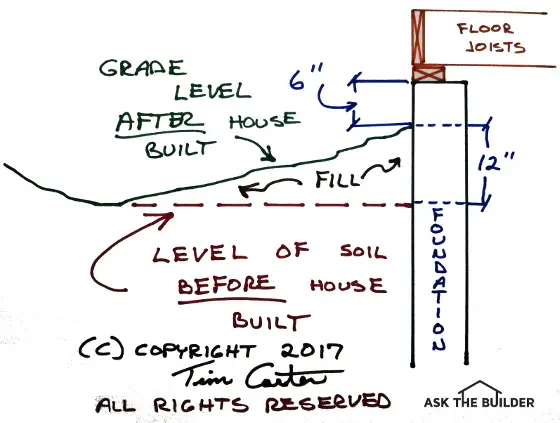
I made this drawing. You can see the foundation wall with a typical sill plate and floor joist. The red line is the lot before the excavator shows up. The top of the foundation should end up 18 inches ABOVE the red line. Use the dirt from the hole to create the slope away from the foundation. (C) Copyright 2017 Tim Carter ALL RIGHTS RESERVED
All it means is that within 10 feet of your foundation, the ground should slope at least 6 inches. This change in elevation could happen within a foot, meaning it would be a very visible slope very close to your foundation walls.
Can You Create a Sloped Swale Around Your Entire Home?
Yes, you can create a water drainage channel or swale around your home.
The builder should have then created an artificial channel around and away from your home that also has a slope to it. The water flowing away from your foundation would enter this channel and then flow, by gravity, completely around your home.
There should never be any ponding in this shallow channel. To achieve great water drainage, a slope of at least 1/8 inch per foot is required. More slope is better if you can tolerate it on your lot.
Can You Capture Subsurface Water?
Subsurface water can be captured using a perforated pipe in a trench.
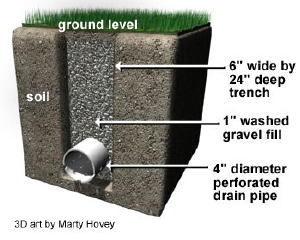
Cross-section of a Linear French Drain including the all-important perforated french drain pipe. Copyright 2017 Tim Carter ALL RIGHTS RESERVED - Do NOT COPY this graphic.
Surface water is but one challenge around your home. You also need to deal with subsurface water that flows through the soil towards your foundation and crawlspace walls.
You can capture and divert this subsurface water by digging a narrow trench in the center of the artificial channel around your home. The trench contains a perforated pipe that collects and diverts the water away from your home.

In the center of this gravel is a linear french drain. Some call them trench drains as I dug a trench and put in a perforated pipe. This area never has standing water in it now. Copyright 2017 Tim Carter ALL RIGHTS RESERVED
How Deep and Wide Should the Linear French Drain Be?
The linear french drain should be about 2 feet deep and 6 inches wide. The bottom of the trench should be parallel with the top of the artificial channel until it gets around your home.
The trench extends past your home towards the lowest point of your lot. The pipe slope can be reduced when the pipe passes the house. The pipe eventually pops out of the ground.
If you do this job, you're creating a linear french drain. They are extremely effective at solving water drainage issues because they intercept the water flowing through the soil. The water is channeled away from the house after it enters the perforated pipe.
Are There Step-by-Step Instructions to Install a Linear French Drain?
Do you want a step-by-step procedure on installing a Linear French Drain? Tim's Linear French Drain Streaming Video Series shows you how to keep your basement and crawl spaces dry or on the image below to order Tim's Streaming Video.
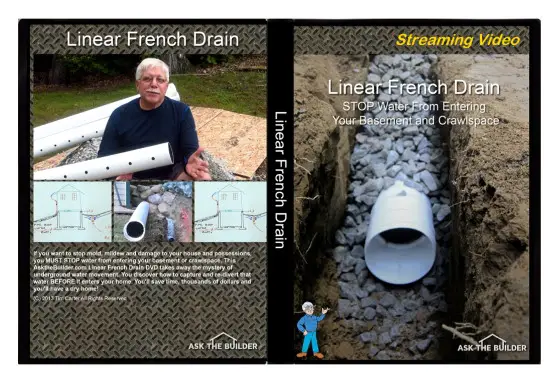
Do your own DIY install of a Linear French Drain with Tim Carter's time-tested methods and materials! CLICK IMAGE TO ORDER NOW!
What Kind of Gravel Should be in the Trench?
You install a 1-inch layer of rounded or slightly angular gravel that's the size of large acorns into the bottom of the trench.
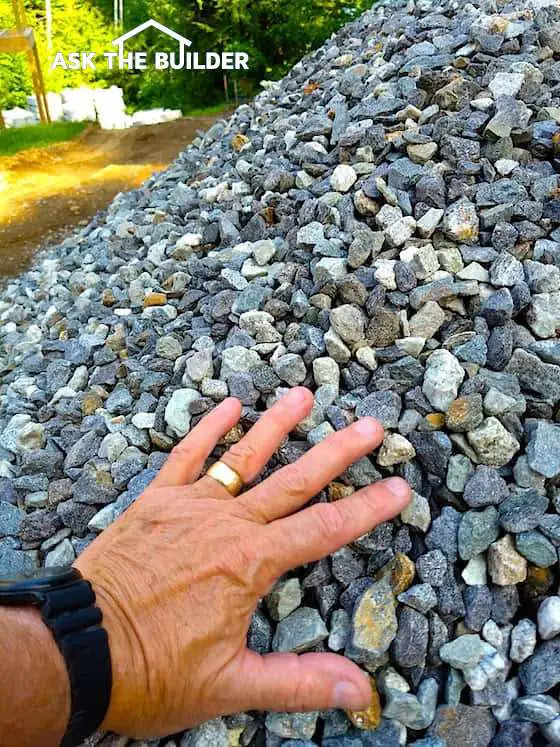
This is perfect gravel to put in the trench for great water drainage. Note there's NO SAND. The water can move fast through the large voids around each stone. Copyright 2018 Tim Carter
Gravel is laid on the perforated drain pipe. The entire trench is then filled with the rounded gravel. This system readily collects subsurface water before it attacks your home. Water will flow from the end of the drainpipe where it eventually breaks through the surface of the ground.
In conclusion, you can easily improve the water drainage around your home using a combination of sloped soil and simple linear french drains. You should install the linear french drains after the final grading is completed. Be sure to do it before the grass seed is sown.
Column 984
